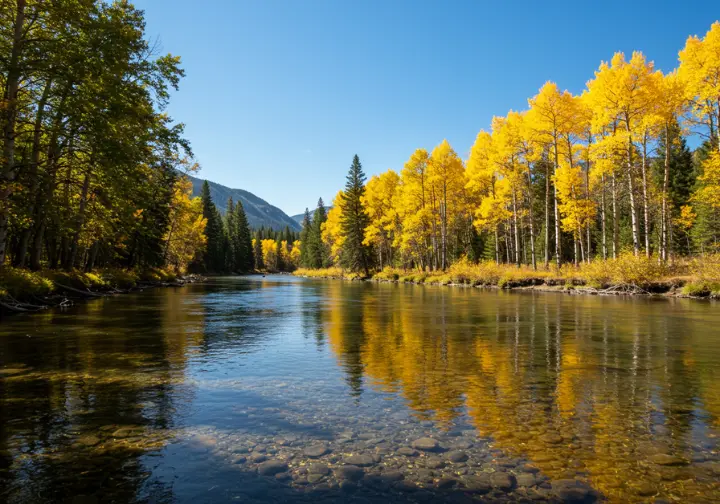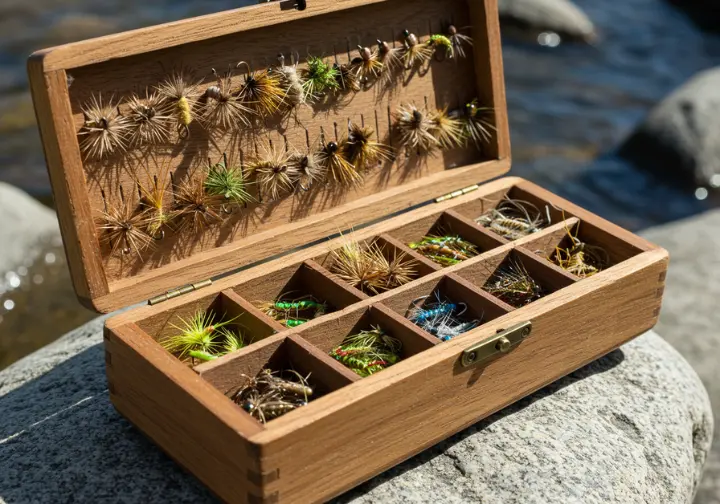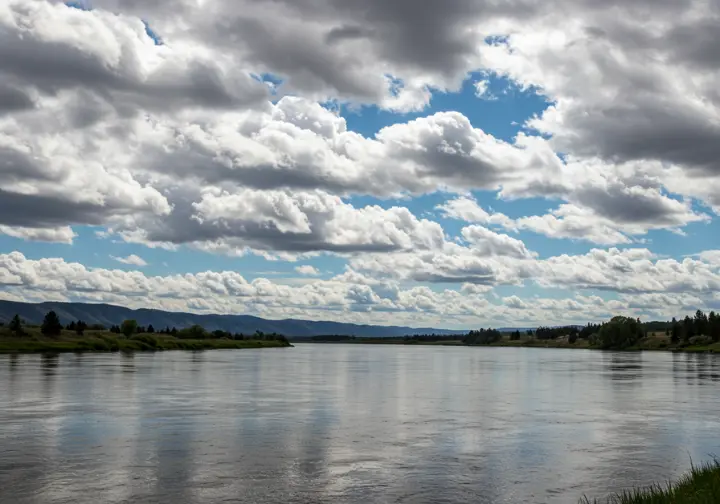Discover the best time to fly fish in montana! Unlock the state’s secrets by focusing on seasonal hatches and river conditions. The early season promises less crowded waters and enthusiastic trout after winter, while summer brings explosive dry fly fishing. The late season rewards patience with aggressive fish, particularly in October. Target the Big Hole River (April-November) and Paradise Valley (late summer). Remember, adaptability is key; USGS gauges and Montana FWP regulations are valuable resources to know the best time. Learn more about Montana’s angling treasures.
In this article
Montana Fly Fishing Seasons

You’ll find how Montana’s fly fishing seasons offer unique experiences throughout the year. We’ll talk about the early season’s promise, the peak summer action, and the prime late-season fishing. Don’t forget those who accept the challenge: winter anglers! Summer brings explosive dry fly fishing on rivers like the Madison, where hatches peak in June.
Early Season Rewards (Mar-Jun)
Early season fly fishing in Montana kicks off as rivers thaw, typically running from late March through mid-June, offering unique opportunities before peak season crowds arrive. You’ll find trout growing active after winter. April and early May are prime before spring runoff hits. Aquatic insect hatches like BWOs and Mother’s Day Caddis kickstart the dry fly fishing season and aquatic insects emerge. Focus on deep pools over 4 feet where trout conserve energy during colder early season temperatures.
Early Montana fishing offers less pressure; visualize having Montana rivers almost to yourself. Tailwater rivers, like the Madison, are consistent because of regulated flows, meaning reliable trout fishing spots. Target trout on spring creeks. You’ll experience rewarding days as the fish keenly rise. If you’re into that kind of fishing season, early Montana fishing offers great fishing opportunities.
Peak Summer Action (Jun-Aug)
From mid-June through August, we hit peak fly fishing season in Montana, boasting some of the most reliable and enjoyable weather any angler could ask for. Almost all Montana rivers fish well. June and July mean prolific hatches across the rivers, and exceptional dry fly action for trout. The Salmonfly hatch is legendary, offering chances to catch large trout with big dry flies.
As summer goes on, terrestrial fishing heats up. Toss hoppers near grassy banks. Expect explosive strikes! Water temps climb in August, so fish mornings. We’ve all got to practice ethical handling. Expect other anglers, too. Consider trying less-crowded water for a shot at trophy trout. You won’t regret fly fishing Montana in the summer! Polarized sunglasses cut glare and help spot trout in clear summer waters.
Prime Late Season Fishing (Sep-Oct)
You’ll want to layer up; it can get chilly. Many say October is the best month; it might be for you too. Fall fishing provides peace and exceptional rewards. Focus on reading water to identify prime trout holding lies during this season.
Challenging Winter Opportunities (Nov-Mar)
Though most anglers hang up their waders, Montana fly fishing doesn’t entirely stop during the winter months (November through March), but it sure does get challenging, and is definitely not recommended for casual fishing trips. You’ll likely face harsh conditions. Nevertheless, some waters reward the dedicated. Tailwater fisheries, like the Missouri, offer relatively stable conditions, even in mid-winter.
If you brave winter fishing, nymph fishing is your best bet for trout. Midges are key, so stock up on small flies, sizes 18-22. Slow, deep runs are where trout conserve energy. Few fly anglers are out there, so you’ll have solitude. Bear in mind, proper layering is essential. Landing a trout on a crisp winter day makes it worth the struggle. It is an experience reserved for hardy and persistent people. Target slow-moving eddies where trout gather to feed on drifting midges.
Targeting Specific Montana Rivers

Don’t you want to know which Montana rivers are fishing best right now? You’ll find killer hatches on the Big Hole if you time it right, and the Madison’s got hotspots you just can’t miss. We’ll additionally check out the Yellowstone, where you’re guaranteed great opportunities. Matching the hatch increases your chances of landing trophy trout on these legendary waters.
Big Hole River Timing
If timing is everything, then comprehension of it on the Big Hole River is your key to unlocking Montana fly fishing success. Your fishing trip can stretch from April to November, each month offering something unique! In spring, nymphing’s your best bet before the real good fishing starts. Then, from mid-April onward, expect Skwala and Mother’s Day Caddis hatches, with intense dry fly action.
June is prime time as the river clears and the legendary Salmon Fly hatch kicks off. You’ll see the big fish rise! After, you’ll have caddis and mayflies to fly fish with. By august, think hoppers and terrestrial patterns. September? More dry fly! October brings streamer time catching trophy trout. Montana fishing guides are available if you need them! Focus on deep pools and riffles where trout gather for feeding and shelter.
Madison River Hotspots
Now, let us turn our attention to the Madison River, where the fishing can be red-hot. You’ll find the upper stretches below Quake Lake fish well early, offering nymphing before the runoff. April’s prime for pre-runoff action. May brings the Caddis hatches.
Watch for the famous salmonflies in late June/early July—big trout love ’em! You’ll want to be there with your biggest dry fly stonefly patterns. August and September bring terrestrial action. Fall’s for big browns and rainbows moving from Hebgen Lake.
The Lower Madison, below Ennis Lake, fishes great earlier and later, especially for the Mother’s Day Caddis. Recall, summer’s usually too warm. There is special October fishing for trout moving out of Hebgen Lake. Don’t miss out. Float fishing is popular here. Fish on!
Yellowstone River Opportunities
For anglers chasing diverse fishing experiences, the Yellowstone River stands out, offering opportunities which stretch from late March through October, mirroring Montana’s extended season. Its character changes dramatically along its length.
You’ll find the Paradise Valley section, near Livingston, heaven after the spring runoff, frequently late July through September. That area is prime for fly fishing with different flies; you can target trout with dry flies during July. Late summer highlights hopper fishing, where throwing hopper patterns to the bank might reward you with big fish!
Within Yellowstone National Park, you’ll find the season kicks off in late May or early June. Those looking for cutthroat trout should look to the Lamar River and Soda Butte Creek. Anglers enjoy sight fishing for those native fish there. The Yellowstone rivers offer something for everyone! You might even get the chance to plunge from a drift boat. Guadalupe bass thrive in similar conditions, making the Llano River a Texas counterpart to Montana’s legendary waters.
Mastering Montana Insect Hatches

You’ll up your game when you key into the insect hatches. Aren’t you ready to learn the secrets of spring, summer, and fall? Let’s unlock Montana’s fly fishing potential together. Matching fly size to local conditions is crucial for fooling pressured trout.
Spring Hatch Significance
As winter loosens its grip, spring hatches kick off the most exciting time for us fly fishing fanatics since they offer the first big chance to trick trout into feeding on the surface after months of slim pickings. These spring hatches bring the first substantial dry fly opportunities, drawing fly anglers keen for the topwater action. Knowing the timing of aquatic hatches is key, as fish begin keying on specific insects.
These good days are fueled by insects like BWOs, offering great fly fishing with small flies time. Skwalas likewise appear, getting trout excited! March Browns offer more chances, and the Mother’s Day Caddis is a blizzard of bugs, providing exceptional dry fly fishing. You’ll want to “match the hatch” – carrying a diverse fly selection is important for spring success.
Summer Hatch Bonanza
Spring hatches have their moment, but the fly fishing story in Montana hits a new level once summer rolls in. The summer hatches are an insect smorgasbord for fish! You’ll have consistent dry fly fishing, since the stoneflies, mayflies, and caddisflies are all emerging.
The Salmonfly hatch kicks things off, tempting trout with big meals. Golden Stones follow close behind. Then, PMDs emerge, offering technical dry fly challenges if the trout turn selective. Yellow Sallies and various Caddis species are everywhere, with caddis sometimes being best in the evening. Plus, terrestrial fishing turns on when grasshoppers and ants become important food. Consequently, being prepared for all these hatches is key to conquering Montana summer fly fishing!
Fall Hatch Strategies
Fall fly fishing, from September to October, presents unique hatch opportunities and strategic adaptations as water temperatures drop, and trout, especially browns, get more aggressive before spawning. Your tactics should change as water temperatures fluctuate.
BWOs show up throughout the fall, with peak hatches in October. Don’t miss out on those mid-day dry fly fishing opportunities. Match the hatch with your best BWO imitations.
Though terrestrial insects may decline, streamer fishing for big brown trout heats up! Toss those big flies and hang on. Nymphs too remain productive; think Pheasant Tails and Hare’s Ears. Adjust depth and weight. Be versatile and adapt. Fall hatches can be rewarding, and with our catch rates on the rise, you will be in for the time of your life!

You’ll quickly learn Montana’s weather rules the fishing! Aren’t you ready to adjust your tactics for spring runoff, summer heat, and unpredictable fall days? We’re going to show you how.
Spring Runoff Realities
The Madison’s runoff often starts mid-May, but this depends on the snowpack. Adapt, use local intel, and maybe you’ll outsmart the muddy water.
Summer Heat Considerations
Mother Nature throws us a curveball, and the summer heat considerations impact your fishing. Fishing varies as the water warms; trout seek cooler water. You’ll find higher catch rates in early mornings and late evenings. Plan your time wisely! Focusing on these times will vastly improve your personal fishing priorities.
During those hot days, your fishing preference should change. Terrestrial insects become key, so try grasshopper or ant patterns. Low river flows can concentrate fish. You may additionally find more success on lakes. Keep an eye on water temperature—above 68°F stresses fish; stop fishing or find cooler water. Grasping these summer heat considerations will improve your fishing experience.
Fall Weather Variability
As autumn descends upon Montana, expect cooler air and water temperatures which invigorate trout, kicking off increased feeding as they prep for winter and spawning. Nevertheless, fall’s beauty hides unpredictable weather. It’s a good time to fish days but weather forecasts are crucial cause weather can change quickly from sunny to snowy. Pack layers! These are choice dates to be prepared for anything.
Cloudy mountain days often mean Blue Winged Olive hatches, so dry fly fishing can be astonishing, making it my favorite time of year. Sunny day? Try terrestrials or nymphing. Recollect, as we reach the fishing end, earlier snow’s possible. Whereas it’s a nice time, accessing some spots gets tough. Adapt your fly fishing game to daily conditions is a key to the game!
Regulations and Expert Insights

You’ve likely got questions about Montana’s fishing rules, and we’ll break them down. Guides hold tons of local knowledge, so we’ll uncover how to use this. What happens when conditions get tough; you’ll see how to overcome the angling challenges.
Understanding Fishing Regulations
To be a responsible angler and protect Montana’s incredible fisheries, knowing the Montana Fish, Wildlife & Parks (FWP) fishing regulations is crucial. You must have a valid license and grasp specific rules for the waters you’ll be fishing. These fishing regulations cover season dates, limits, and tackle restrictions.
General season dates vary by district, and Montana Fish, Wildlife & Parks (FWP) can issue emergency regulations. It’s on you to check for closures owing to conditions like drought or high water. Daily catch limits, specific rules, and tackle restrictions, such as single barbless hooks, additionally change. Don’t skip checking the FWP website. Not knowing the specific rules isn’t an excuse, and could cost you.
Leveraging Guide Knowledge
Given the intricacies of Montana’s fishing regulations and the kinetic nature of its rivers, seasoned local fly fishing guides offer priceless knowledge about peak timing, current river conditions, and effective techniques. They’ve spent years observing these waters. A guided fly trip, especially on unfamiliar stretches, is indispensable.
Why? An expert Montana guide knows the less-crowded fishing spots, especially vital during the summer months. They’re dialed into hatch timing, ensuring you’re armed with the right flies. If you’re after trophy brown trout, October, with its streamer fishing opportunities, is their specialty. You’ll gain insight into where those lunkers hold. Forget guessing; guides provide real-time data, bridging the gap between seasons and current river conditions.
Overcoming Angling Challenges
Traversing Montana’s waters involves more than just casting a fly. You’ll face challenges. Spring runoff turns big rivers into unfishable chocolate milk. You can try tailwaters or adjust your plans. Summer’s heat shrinks flows; fish early or seek higher elevation streams. Crowds on popular spots? We’ve all been there. Try weekdays, less-known creeks, or backcountry fishing accessed by boat. Hiring a guide and employing different fishing styles and going somewhere on a float will take you away from the masses.
Montana weather changes fast. Pack layers. Varying river flow demands adjusting techniques. High flows? Heavier nymphs work. Clear, low flows? Stealth is key. If you’re wade fishing mountain streams or hiking to alpine lakes, understand water flow.
Planning Your Optimal Trip
Planning your ideal Montana fly fishing trip boils down to matching your priorities with the state’s ever-changing conditions. The best time to fly fish in Montana and secure the best time to fish in Montana depends on what you’re after. For solitude on your next fishing trip, consider April-May or late September-October. Chasing hatches? Mid-June to August’s your window, but expect company. If big brown trout are your quarry, October is prime for pre-spawn aggression, so focus on streamer fishing.
Montana boasts diverse fishing opportunities, from famous tailwater fisheries to freestone streams. Tailor your trip: the Big Hole for Salmonflies, the Madison for fall lake-run fish. Recall river flows fluctuate! Always check current conditions, USGS gauges, and regulations before heading out. Be prepared for anything, pack layers, and stay flexible. Real-time adjustments are key to success when seeking large trout.
Popular Questions
What Gear Do I Need Beyond Rod and Reel? +
Are There Guided Trips for Beginners? +
Where Can I Find Lodging Near Rivers? +
How Much Does a Montana Fishing License Cost? +
Is It Safe to Drink the River Water? +
We are a participant in the Amazon Services LLC Associates Program, an affiliate advertising program designed to provide a means for sites to earn advertising fees by advertising and linking to Amazon.com. As an Amazon Associate I earn from qualifying purchases. We also participate in other affiliate programs. The information provided on this website is provided for entertainment purposes only. We make no representations or warranties of any kind, expressed or implied, about the completeness, accuracy, adequacy, legality, usefulness, reliability, suitability, or availability of the information, or about anything else. Any reliance you place on the information is therefore strictly at your own risk. Additional terms are found in the terms of service.









